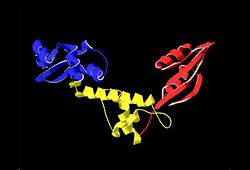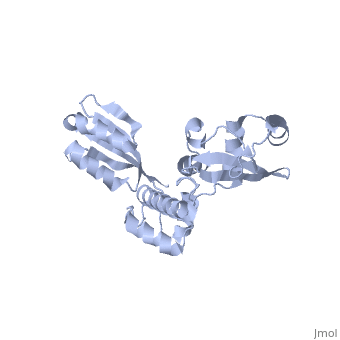Overview
The human Shwachman-Bodian-Diamond syndrome (SBDS) protein belongs to a very conserved family of proteins of unknown function; orthologues found in Archaea, as well as plants and other eukaryotes [1]. Evidence has been provided that the SBDS protein orthologues may play a role in RNA metabolism [1]. Two groups of SBDS orthologues have been identified. Archaea, animals, and fungi have SBDS proteins with approximately 250 amino acid residues[1]. However, SBDS protein of plants and protists has the C-terminal extensions around 100 to 250 amino acid residues [2].
Structure
The structure of the Archaeoglobulus fulgidus SBDS protein orthologue has been determined at the resolution of 1.9 angstroms that showcases a three domain architecture [1]. The domain that has many disease mutations is the N-terminal domain; containing a mixed alpha/beta fold. The central domain has a three-helical bundle, and the C-terminal domain has a ferredoxin-like fold [1].
The Archaeoglobus fugidus othrologue of the human SBDS protein (AfSBDS) is a monomer of 240 amino acid residues with water molecules consisting of three domains
[1]. Domain I is a N-terminal domain consisting of residues 5-87. Domain II is a central domain consisting of residues 86-161. Domain III is a C-terminal domain consisting of residues 162-234
[1]. This has been described as a V-shaped molecule with an overall dimension of about 54x59x73 Å (Figure. 1)
[1]. A central cavity (about 10 Å deep and 24 Å long) is created at the interface of the three domains
[1].

Figure 1. Overall structure of the A. fulgidus SBDS orthologue described as V-shaped, ribbon representations. Domain I is coloured blue, domain II is coloured yellow, and domain III is coloured red.
[1] Domain I is a mixed αβ topology consisting of four β strands and four α helices arranged as a 3-stranded anti-parallel β sheets. Helices α1 and α2, along with the intervening loop, line the face of the cleft between Domains I and III
[1].
Domain I is also called the FYSH (Fungal, Yhr087wp, Shwachwan) domain because of its distinctive structural homology with a single domain protein Yhr087wp from S. cerevisiae [1]. Yhr087wp is non-essential, localizing to both the nucleus and cytoplasam of yeast cells, and has a role in RNA metabolism [1]. Most mutations of the SBDS protein are found to occur in this domain. Domain II is a compact three-helical bundle structurally similar to the junction recognition site of E. coli [1]. Domain III is made of a four-stranded anti-parallel β-sheet with two α helices packing against the concave surface of the sheet [1]. The βαββαβ folding topology is a ferredoxin-like fold which is usually seen in many RNA binding proteins, including nuclear ribonucleoproteins and small nuclear ribonucleoproteins [1].
The structure of the orthologue for the human SBDS protein from A. fulgidus (AfSBDS) has been determined because of the significant amount of amino acid conservation between the two [1]. It had been hypothesized that by doing so, clues could be obtained as to what the function of the protein may be, as well as being able to determine the effects of the mutations found in SDS [1]. The structure has been determined via x-ray crystallography with a resolution of 1.9Å and a free R factor of 24.9%. Crystals were grown from SeMet substituted His6-AfSBDS protein [1]. This technique was an appropriate form of methodology, as it allows for structural comparison with other potentially homologous proteins, as well as allowing for the mapping of mutations onto the structure [1].
Potential Functions
Although the SBDS protein has been shown to have an unknown function, the SBDS protein displays a potential for a multiplicity of functions. It has been shown that SBDS proteins may play a role in growth, cell cycle progression, and apoptotic control[3]. It is thought that the phenotype of SDS patients is largely due to unregulated of apoptosis by an increase in FAS death receptors[3][4]. This has led to the assumption that the SBDS protein is a pro-survival protein[4]. Increased angiogenesis due to upregulation of the growth factor, VEGF, has been reported in SDS bone marrow cells. This upregulation of VEGF is thought to be a compensatory mechanism for increased apoptosis[3]. The resultant angiogenesis may play a part in the increased propensity of SDS patients for leukemia as mutations may develop in bypassing the apoptotic cycle and increased angiogenesis can lead to expansion of tumor cells[3]. However, it is unclear if increased apoptosis that is due to an increase in FAS death receptors is because of a primary involvement of SBDS protein in the pathways, or if the pathways are secondarily stimulated because of the reduction of the SBDS function[3]. Interestingly, another potential function of SBDS that has also been noted is that SBDS stabilizes the mitotic spindle that SBDS deficiency leading to mitotic abnormalities (multipolar spindles and centrosomal amplification).[5] This can also result in increased apoptosis and tumorigenesis[5]. The multiplicity of the function of SBDS could result in an additive phenotypic effect.
Mutations
SBDS protein mutations persist into the Shwachman-Diamond syndrome (SDS) with the conversion mutation caused by the recombination between the SBDS gene and a pseudogene [1]. The SDS may also formulate from the frameshift and missense mutations of the SBDS genes. The mutations are predominantly found at the N-terminal domain. In turn, this results in less expression of the SBDS protein (absence of SBDS protein has been shown to be lethal in mice and patients with two void SBDS alleles have not been found)[1]. The SBDS protein has an important function in some cells is implicated by the lethality found in mice on its absence. The phenotypes associated with SDS, in addition to the lethality associated with its absence, imply that the SBDS protein has an essential function in some cells[1]. Individuals affected by SDS have bone marrow dysfunction, skeletal abnormalities, resultant pancytopenia, a predisposition to leukemia, and insufficient exocrine pancreatic function[1][6].
Based on the crystal structure of an orthologue of the SBDS protein, AfSBDS, various previously identified SBDS mutations onto the molecular surface of the AfSBDS protein have been mapped. In this way, it also has been determined that mutations can be categorized into three main groups: 1. Protein truncations which would be expected to result in loss of protein function. 2. Missense mutations that destabilize the fold, predicted to result in reduction or loss of protein stability. 3. Missense mutations that affect the electrostatic potential of the protein surface, possibly modifying surface epitopes [1]. To verify the predictions associated with the missense mutations, in vitro and in vivo experiments have been performed with the S. cerevisae SBDS ortholog Ylr022cp to further test the mutational consequences. The disease related mutations have significant negative effects on the growth of the yeast cells[1]. Deletion of the FYSH domain renders the protein nonfunctional, yet it has been found that both domains I and II are necessary for functionality of the SBDS protein. Interestingly, although several of the mutations have negative effects on cell growth, most of the SDS-related missense mutations do not deter Ylr022cp function[1]. Mapping of known mutations onto the structure reveals that most SBDS mutations are located in the N-terminal domain and allows for predictions regarding the effect of various known SBDS mutations. Most missense mutations of the yeast SBDS homolog Ylr022cp do not result in dysfunction[1].
SBDS Association with RNA Processing
It appears that SBDS protein deficiency has variable effects dependant on cell type. This is suggested by the tissue specificity in patients with SBDS gene mutations[7]. Various orthologs show some diversity in functionality, as well, usually associated with either ribosome biogenesis or RNA processing[7]. The active rRNA transcription determines the localization of the human SBDS protein in the nucleolus. Although patients affected with SDS do not show a defect in pre-rRNA processing in their cells, reduced ribosomal synthesis is shown[7]. Human SBDS has been shown to associate with other proteins involved in RNA processing as well[7]. The yeast protein YHR087wp, involved in RNA metabolism, is charged (and is similar in its structure) by the N-terminal domain of the archaeal SBDS protein[1][8]. The distinctive structural homology of the N-terminal domain with that of the Yhr087wp protein involved in RNA metabolism in S.cerevisiae suggests some role for the SBDS protein in RNA biosynthesis[1]. The archaeal SBDS gene is located on an operon that contains RNA processing genes[1]. The amino acid sequence between the archaeal human SBDS protein is highly conserved.
The yeast orthologue, Sdo1p, has been shown to participate in 60S ribosome biogenesis, as well as in the translation activation of ribosomes[2]. The C-terminal found in plants contains a zinc finger domain that can interact with nucleic acids[2]. A high binding and RNA affinity has been shown when even though the C-terminal extension of trypanosomes does not show this zinc finger domain [2]. Direct RNA binding has not been shown for orthologues without the C-terminal extention, but ribosome association has been shown[7]. The fact that the C-terminal domain has a ferredoxin-like fold that is associated with many RNA binding proteins is also suggests of some role in RNA metabolism[1]. The FYSH domain is negatively charged, and the central and C-terminal domains are mostly basic. Nucleic acid binding proteins often use basic residues to connect with the sugar phosphate backbone, further indicating an RNA link [1].
3D structures of SBDS
Updated on 21-March-2022
2kdo, 2l9n – SBDS – human – NMR
1t95 – SBDS – Archaeoglobus fulgidus
2wbm – SBDS homolog – Methanothermobacter thermautotrophicus
5an9, 5anb, 5anc, 6qkl – SBDS in 60S ribosomal subunit – slime mold – Cryo EM
References


